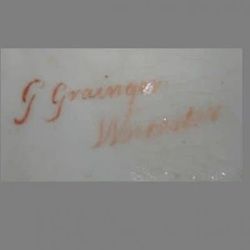
Вустерский фарфор Грейнджера был основан Томасом Грейнджером (1783–1839), который был учеником на вустерской фабрике Роберта Чемберлена вместе со своим партнером Джоном Вудом. Основанная в 1801 году в качестве конкурирующей компании по производству фарфора в арендованной собственности в Лоусморе, Вустер, они, как и Джайлз и Чемберлен до них, начали с украшения пустых фарфоровых изделий, изготовленных другими компаниями. К 1804 году они рекламировали украшение фарфора в местных газетах и к 1806 году открыли магазин на Вустер-Форгейт-стрит.
Grainger & Wood начала производить свой собственный фарфор к 1807 году и вскоре завоевала хорошую репутацию как производителя полезных, так и декоративных изделий. Богатые узоры, такие как имари в японском стиле, и изысканная чайная посуда составляли серьезную конкуренцию городским фабрикам Chamberlain и Barr, Flight & Barr.
Также были созданы некоторые исключительно прекрасные цветочные и пейзажные картины, обычно на кружках с прямыми стенками или классических вазах. После фабричного пожара в 1809 году у ворот Святого Мартина была построена новая фабрика.
В 1839 году, после смерти Томаса Грейнджера, его сын Джордж взял на себя управление компанией и поощрял производство изысканных декоративных изделий. Грейнджер принял стиль неорококо в 1830-х и 1840-х годах, производя широкий ассортимент декоративных ваз, посуды для чая и десертов.
Этот стиль возрождения, характеризующийся экстравагантными формами, яркими насыщенными цветами и позолотой, был в моде у подающих надежды промышленников, которые могли позволить себе тратить деньги на свои дома. George Grainger & Co диверсифицировала свою продукцию, производя тисненые плитки для каминов, неглазурованные фарфоровые фигурки и дверную фурнитуру. Они также добились успеха в разработке химического фарфора (для лабораторного использования) и полуфарфора.
После смерти Джорджа Грейнджера в 1889 году фабрика Грейнджера была продана компании Royal Worcester, которая продолжала производство на площадке у ворот Святого Мартина, пока окончательно не закрыла завод в 1902 году. В 1890-х годах фабрика Грейнджера специализировалась на производстве предметов ручной росписи для демонстрации. , богато украшенные драгоценными камнями изделия и фарфор из слоновой кости в стиле Royal Worcester. Проколотые изделия Grainger были в основном работой Альфреда Барри. В отличие от проколотых изделий Royal Worcester, дизайн Grainger, как правило, имеет криволинейный стиль, а отверстия соответствуют заданному шаблону, созданному в форме.
Многие из рабочих Грейнджера перешли на фабрику Royal Worcester в 1902 году, в том числе знаменитая семья художников Стинтон. Даже в начале 21 века некоторые формы и конструкции фабрики Грейнджера все еще использовались Royal Worcester.







